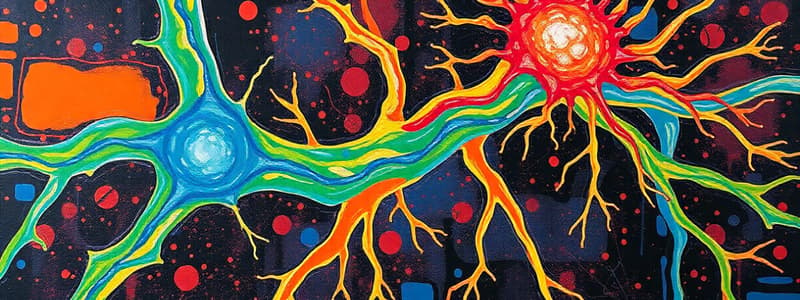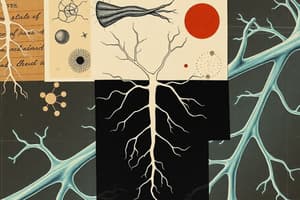Podcast
Questions and Answers
Which of the following statements about the sympathetic nervous system is accurate?
Which of the following statements about the sympathetic nervous system is accurate?
Where are collateral ganglia located in relation to the spinal cord?
Where are collateral ganglia located in relation to the spinal cord?
Which of the following correctly describes the terminal ganglia?
Which of the following correctly describes the terminal ganglia?
What is the primary function of the paravertebral ganglia in the autonomic nervous system?
What is the primary function of the paravertebral ganglia in the autonomic nervous system?
Signup and view all the answers
What effect does the sympathetic nervous system have on salivary glands?
What effect does the sympathetic nervous system have on salivary glands?
Signup and view all the answers
What is the primary function of afferent neurons?
What is the primary function of afferent neurons?
Signup and view all the answers
Which of the following statements about the somatic nervous system is correct?
Which of the following statements about the somatic nervous system is correct?
Signup and view all the answers
What characterizes the autonomic nervous system compared to the somatic nervous system?
What characterizes the autonomic nervous system compared to the somatic nervous system?
Signup and view all the answers
Where are the cell bodies of afferent neurons located?
Where are the cell bodies of afferent neurons located?
Signup and view all the answers
What is the role of autonomic ganglia?
What is the role of autonomic ganglia?
Signup and view all the answers
Which type of muscle is regulated by the autonomic nervous system?
Which type of muscle is regulated by the autonomic nervous system?
Signup and view all the answers
What distinguishes the two divisions of the autonomic nervous system?
What distinguishes the two divisions of the autonomic nervous system?
Signup and view all the answers
Which chemical transmitter is associated with both divisions of the autonomic nervous system?
Which chemical transmitter is associated with both divisions of the autonomic nervous system?
Signup and view all the answers
Study Notes
Autonomic Nervous System Structure and Origin
-
Afferent neurons carry sensory information from receptors in the skin and organs to the central nervous system
- Also known as sensory neurons
- Cell bodies are located outside of the spinal cord
-
Efferent neurons carry motor information from the brain to the peripheral nervous system
- Also known as motor neurons
- Cell bodies are located in the ventral horn of the spinal cord
Autonomic Nervous System Divisions
-
Autonomic Division regulates involuntary bodily responses
- Relays information from the dorsal root ganglion
-
Somatic Division controls voluntary movement by skeletal muscles
- Relays motor information via the ventral root
-
Sympathetic Nervous System
- Originates in the thoracolumbar region of the spinal cord
-
Parasympathetic Nervous System
- Originates in the craniosacral region of the spinal cord
-
Sympathetic Nervous System
- Controls "fight or flight" responses
- Uses norepinephrine and acetylcholine as neurotransmitters
-
Parasympathetic Nervous System
- Controls "rest and digest" responses
- Uses acetylcholine as a neurotransmitter
Autonomic Ganglia
- Definition: Collection of neurons outside the central nervous system
- Function: Acts as a distributing center
-
Types:
-
Paravertebral ganglia (lateral)
- Present on both sides of the vertebral column
- Relay of the sympathetic nervous system
-
Collateral ganglia
- Present midway between the spinal cord and viscera
- Relay of the sympathetic and parasympathetic nervous systems
-
Terminal ganglia
- Present near or inside the viscera
- Relay of the parasympathetic nervous system
-
Paravertebral ganglia (lateral)
Functions of the Sympathetic Nervous System
-
Head and Neck:
-
Eye:
- Pupil dilation (mydriasis) due to contraction of the dilator pupillae muscle
- Elevation of the upper eyelid (widening of the palpebral fissure)
- Decreased tear secretion of the lacrimal gland
- Salivary glands: Decreased salivary secretions
-
Eye:
-
Thorax: (Heart and Lung)
-
Heart:
- Increased excitability and rate of conduction
- Positive inotropic effect (increase in force of contraction)
- Positive chronotropic effect (increase in heart rate)
- Vasodilation of coronary vessels
-
Lung:
- Bronchodilation (relaxation of bronchial muscles)
- Vasoconstriction of pulmonary vessels
-
Heart:
Studying That Suits You
Use AI to generate personalized quizzes and flashcards to suit your learning preferences.
Related Documents
Description
This quiz covers the structure and function of the autonomic nervous system, including the roles of afferent and efferent neurons. It delves into the autonomic and somatic divisions, as well as the sympathetic and parasympathetic systems. Test your knowledge on the origins and functionalities of these essential components of the nervous system.



